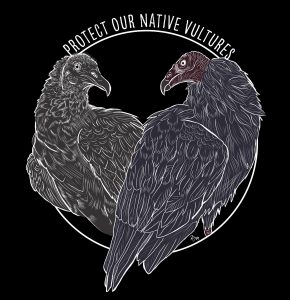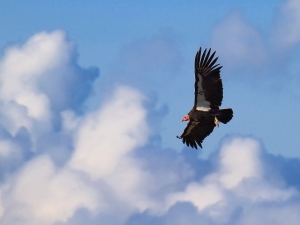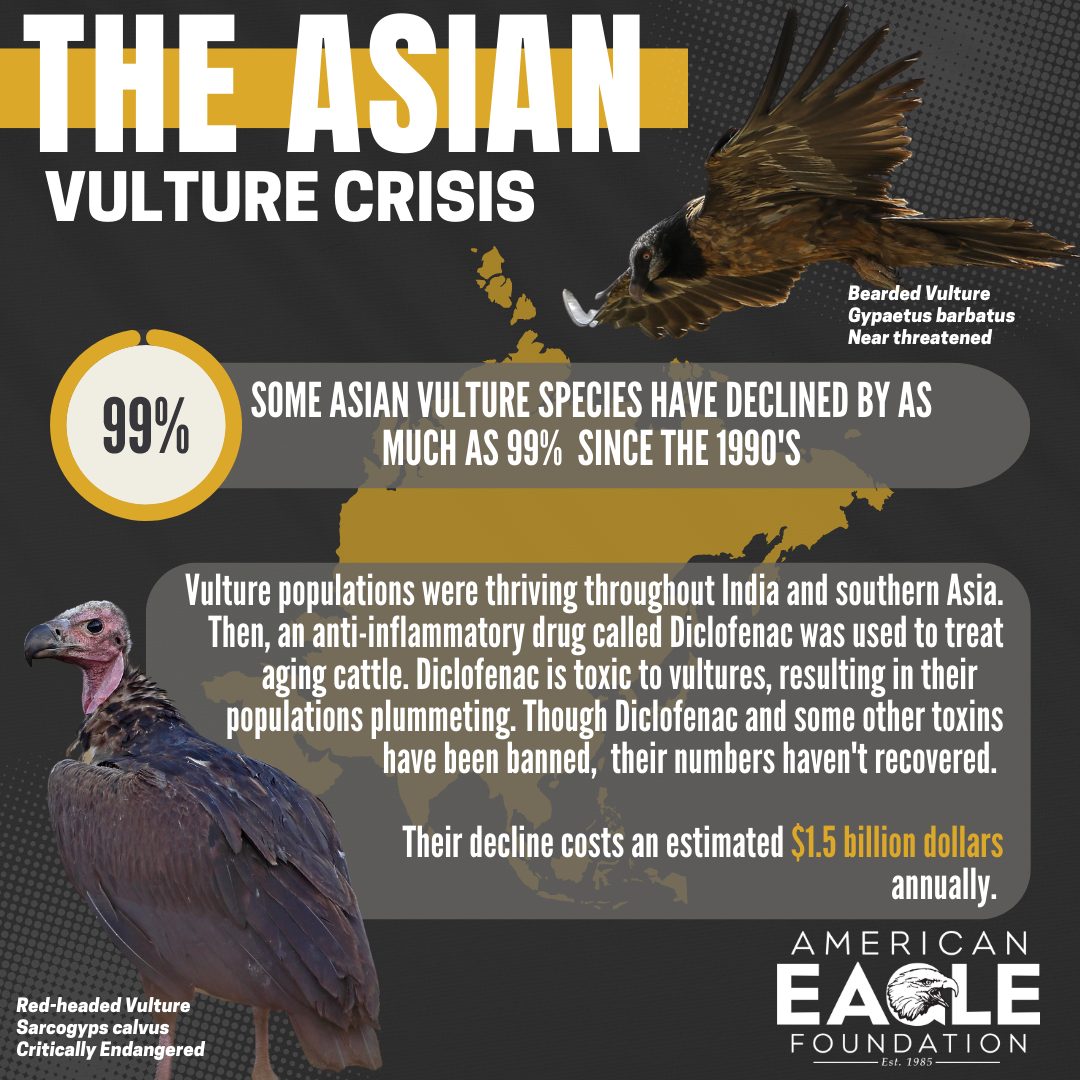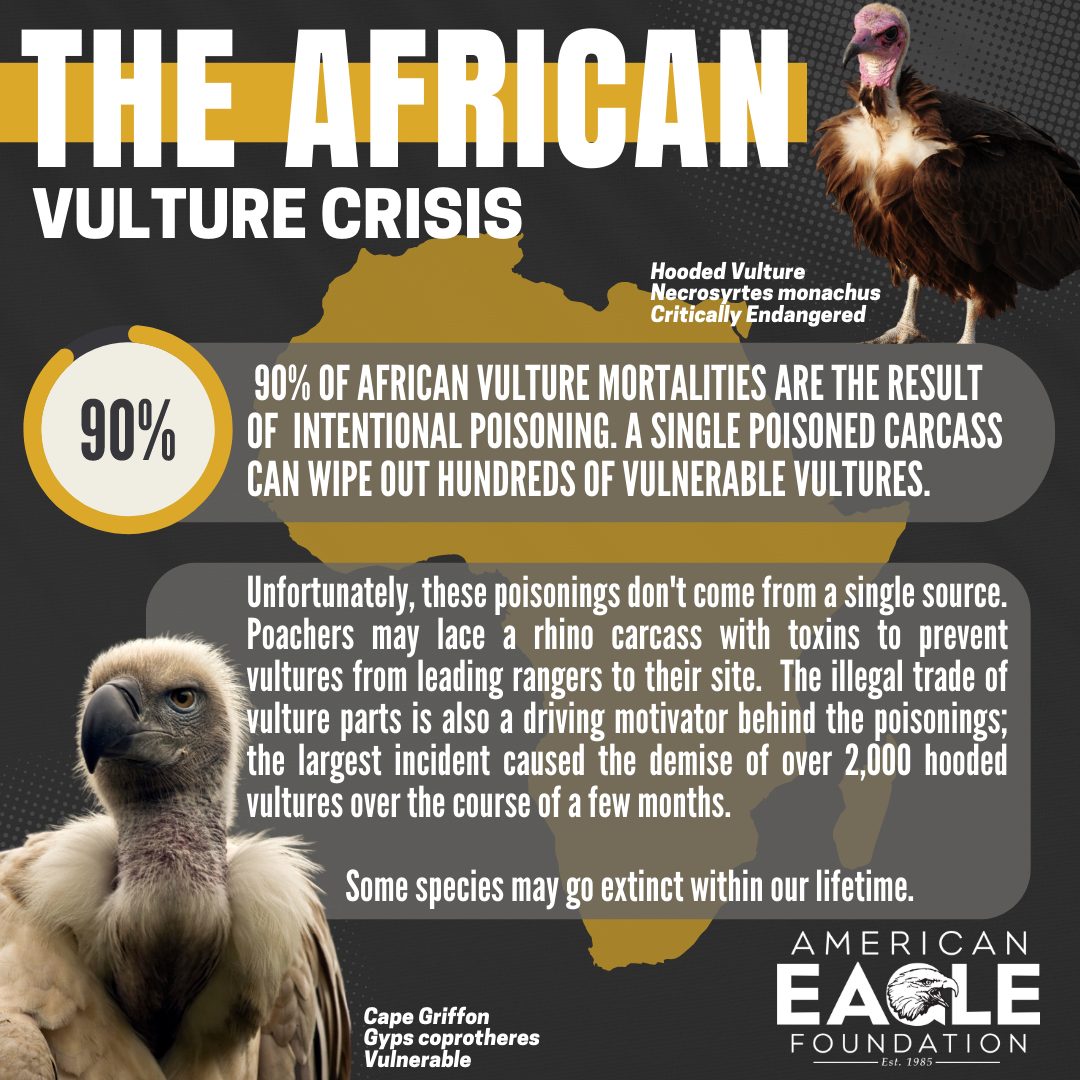International Vulture Awareness Day
Day(s)
:
Hour(s)
:
Minute(s)
:
Second(s)
Be a Voice for Vultures
The first Saturday in September each year is International Vulture Awareness Day. This day is intended to raise awareness around the most imperiled group of birds in the word, all while celebrating their importance within our ecosystems.
Vultures have an unfairly bad reputation. Associated with death and greed, many believe vultures to be cruel, dirty, and ugly creatures. Pop culture is equally unflattering, often casting them in villainous roles. Common phrases like “circling like vultures” or even “culture vulture” have negative meanings.
The truth is that these incredible birds are the unsung heroes of the natural world. They are the only land-dwelling obligate scavengers, meaning that carrion is the cornerstone of their diet, and with this title comes some crucial ecological services, such as mitigating the spread of disease, protecting human and economic health, and slowing climate change (Buechley and Şekercioğlu, 2016).
In order to protect the health of our ecosystems, we must be a voice for vultures.
Carrion Correspondence

Our community already does much to serve as voices for vultures. For this year’s IVAD, we want to hear (or, rather, read) just how much you love them.
We invite all of our fanatic vulture fans to write a letter to their favorite vulture ambassador here at AEF such as Bash, George, or one of our other bald beauties! In exchange for a letter, you will be entered for a chance to win a goody bag including a limited-edition vulture mug, tote, and t-shirt featuring the above design, along with a one-of-a-kind Bash Painting!
Each letter MUST contain at least one of the following:
- One thing you love about our vultures
- One thing you’ve learned from our accounts
- One thing you love about AEF
You’ll receive a BONUS ENTRY if you include Fan Art with your letter!
All letters should be addressed to the attention of your preferred vulture ambassador with the following address:
Attn: Vulture Name Here
510 Kodak Road
Kodak, TN 37764
Note: Any letters received after September 30th will NOT be entered into the raffle.
Bald is Beautiful

One of the easiest ways to be a voice for vultures is to help counter their negative reputation.
First and foremost, vultures are not buzzards! Though “buzzard” is often misused interchangeably with “vulture,” the word refers to the Buteo genus and other hawk-like birds. The red-tailed hawk? That’s a buzzard. The turkey vulture? Not so much.
Even though their role as nature’s janitorial staff seems gross, they are quite clean due to specialized adaptations. When they perch with their wings spread wide, they’re not waiting for something to die! This sunning posture, sometimes called the “Horaltic Pose,” serves a variety of research-proposed uses; the heat of the sun may help straighten or realign feathers, bake off bacteria, and provoke pests to the surface where they might be easily preened off. The two most common theories suggest that vultures sun in the mornings to dry off and thermoregulate (Clark and Ohmart, 1985).
Their stomach acid is so effective that it is capable of neutralizing diseases like rabies, botulism, anthrax, and many more that might prove fatal to humans. Vultures are thought to have the strongest immune system of any vertebrate (Zepeda et al., 2018). Other less-efficient scavengers—like feral dogs—may contribute to the spread of disease, but vultures are a dead-end for pathogens.
When nature calls, some vultures will urinate straight down on their legs. This behavior is called “urohidrosis,” and it helps keep them cool and rinse bacteria off their feet—think of it as a personal vulture hand sanitizer!
Their featherless heads have caused people to call them ugly, but their bald domes feature disease-resistant microbiomes and prevent their meals from sticking to their face (Zepeda et al., 2018). Vultures come in a stunning array of colors and appearances, even with their bald heads.
Some of this visual variety comes from vultures’ genetic diversity. There are two categories of vulture: New World and Old World. New World Vulture refers to those species found in the Americas, and there are seven species within this group. Old World Vultures roam Europe, Asia, and Africa. Though all vultures are scavengers and carrion-eaters, New and Old World Vultures share no relation or common ancestry! They have adapted to become nature’s cleanup crew through a process called “convergent evolution.” This refers to the development of similar traits in unrelated species to fulfill a specific ecological role.
Unfortunately, vultures need our help. Of the 23 species of vulture found worldwide, 16 are threatened, endangered, or close to extinction (Buechley and Şekercioğlu, 2016).
The California Condor
 Photo: Gavin Emmons, 2-12-10, Pinnacles National Park
Photo: Gavin Emmons, 2-12-10, Pinnacles National Park
The California condor, a New World species, is the largest of our North American vultures. With a nearly 9ft wingspan, California condors excel at soaring long distances while minimally flapping their wings. Their energy efficient gliding and acute vision is well suited for helping them locate carrion over massive territories (Finkelstein et al., 2020).
In the mid-1900’s, condors’ populations began to plummet. Early conservation efforts focused primarily on habitat protection, but researchers discovered, almost too late, that poisoning was the primary culprit behind their decline (Finkelstein et al., 2020). Though the use of poisoned coyote carcasses to deter pests played a small part, the primary source of mortality was lead toxicosis from ammunition fragments in abandoned carcasses and gut piles.
When their numbers dwindled to the low 20’s, the remaining wild population was captured for breeding programs. In the wild, condors only laid an egg once ever two years; worse yet, it took juvenile condors six years to reach sexual maturity. Through propagation programs, pairs were successfully double clutched, meaning that they were able to produce multiple eggs within a typical season. The first successful California condor chick was hatched in 1988. The 1,000th condor from captive breeding programs hatched in 2019.
Despite incredible repopulation efforts, California condors still have not recovered self-sustaining populations. Just as humans caused the decline of the California condor, so too will human intervention save the condor.
The Asian Vulture Crisis

Old World Vultures are imperiled to the degree that their decline is referred to as a crisis, and rightfully so!
In the 1980s, there was a robust population of vulture throughout India and southern Asia with 40 to 80 million individuals estimated. A population that big requires an equally big food source to sustain them: cows! This region was populated by over 400 million cows, and only 4% of that population was utilized as a food source due to cattle’s sacred status in the Hindu religion.
From the 1990s through the early 2000s, the previously thriving vulture population plummeted mysteriously. Some species—such as the white-rumped, Indian, slender-billed, red-headed, and Egyptian vultures—declined by up to 99% (Ogada et al., 2011). The Peregrine Fund discovered in 2003 that an anti-inflammatory drug called Diclofenac caused this staggering loss of vultures. This drug was given to relieve the discomfort of aging cows, but it was lethal to vultures, and their communal eating habits ensured that a single cow treated with Diclofenac could wipe out substantive numbers.
In India, the dramatic decline of vultures resulted in the exponential growth of feral dog populations, which also caused a spike in the spread of rabies to humans. Researchers estimate that 47,000 people died of rabies and calculated economic costs to India at $34 billion dollars from 1993 to 2006 (Markandya et al. 2008). South Asian governments have since banned the use of Diclofenac, but Asian vulture populations have not yet recovered.
This tragic situation underscores how vultures are not only crucial to their environment—they also help protect human and economic health!
- Indian Vulture, critically endangered
- Slender-billed Vulture,critically endangered
- White-rumped Vulture, critically endangered
- Red-headed Vulture, critically endangered
- Egyptian Vulture, endangered
- Cinereous Vulture(also known as Eurasian Black Vulture), near threatened
- Himalayan Griffon Vulture, near threatened
- Bearded Vulture, near threatened
- Eurasian Griffon Vulture, least concern
The African Vulture Crisis

Vultures in Africa are imperiled by a perfect storm of factors, resulting in a decline of their population by 80% or more. Loss of habitat, reduced food and water availability, illegal trade of body parts, and powerline collisions are factors behind the crisis, but poisoning and belief-based practices make up 90% of African vulture mortalities (Ogada et al., 2015). There is a common denominator connecting all these factors: humans.
Poisoning can occur when farmers try to protect their livestock from hyenas or lions by lacing a carcass with poison, but, more often than not, vultures are the victims. Unfortunately, poisoning cases are often intentional. Vultures act as sentinels to Park Rangers seeking to stop poachers. Because circling vultures can lead enforcement officers straight to the culprits, poachers will intentionally poison rhino or elephant carcasses to take out the scavengers. Because large carcasses attract equally large wakes of vultures, such offenses can wipe out 500-700 vultures at a time.
Poisoning to harvest vulture parts for belief-based uses currently accounts for the largest known mortality event in Guinea-Bissau, in which at least 2,000 hooded vultures were poisoned between December 2019 through March 2020 (Gomez, 2022). These mortality rates are a debilitating blow to endangered populations that cannot sustain such losses, and the fact that they are intentional underscores the importance of legislation in protecting these imperiled vultures along with the training of anti-poisoning response groups.
- Hooded Vulture, critically endangered
- Ruppell’s Griffon Vulture,critically endangered
- White-backed Vulture, critically endangered
- White-headed Vulture, critically endangered
- Cape Griffon Vulture, endangered
- Egyptian Vulture, endangered
- Lappet-faced Vulture, endangered
- Bearded Vulture, near threatened
- Eurasian Griffon Vulture, least concern
Keep Calm and Carrion
Left unchecked, it is entirely possible that the ongoing vulture crises will result in the extinction of crucial vulture species within our lifetimes. We can be a voice for vultures by supporting the following initiatives:
Asian Vulture Crisis Initiatives
- Supporting the banning of Diclofenac via petitions and legislations; advocating for the use of vulture-safe meloxicam as a substitute.
- The establishment of vulture safe feeding zones, otherwise known as “vulture restaurants.” Here, ethically sourced carcasses are laid out as a poison-free and consistent food source. American Eagle Foundation annually supports the Gachowk community vulture restaurants.
- Supporting the Vulture Conservation Action Plan, as maintained by the Vulture Conservation and Breeding Centre, the Department of National Park and Wildlife Conservation (DNPWC), the National Trust for Nature Conservation (NTNC), and Bird Conservation Nepal (BCN).
African Vulture Crisis Initiatives
- Supporting the Vulture Multi-species Action Plan (Vulture MsAP) and those organizations that fund it.
- Supporting legislation that regulates the sales of pesticides and poisons, enforces the stop of black market trades in vulture body parts, and reduces mortalities from electrocutions and wind turbines.
- Supplementing initiatives to train poisoning-response group and equip them with the necessary Wildlife Poisoning Response Kits. American Eagle Foundation is also fundraising for this initiative.
- Donating to frontline organizations such as VulPro.
New World Vulture Protections
- Educate yourself about vultures! Learn to identify native species in your area and how they help support your local ecosystem.
- Support California condor breeding and research initiatives, such as those operated by the San Diego Zoo, Los Angeles Zoo, and the World Center for Birds of Prey.
- When safe to do so, move roadkill off the side of the road. Keep a small roadkill kit (gloves, collapsible shovel, etc.) in your car.
- Report any wildlife electrocutions on power lines to your local authorities. Up to 14 million birds are electrocuted each year!
- Support the preservation of the Migratory Bird Treaty Act, which provides native vultures with legal protection from persecution.
- Advocate for Vultures. Educate your family, friends, and neighbors about vulture’s virtues.
- Visit American Eagle Foundation’s Native Vultures page for more information about our charismatic local cleanup crew.
Together, we can save our scavengers! Use our hashtags #voiceforvultures or #endangeredwings to share how you’re being a voice for vultures!
References
Buechley E.R, & Şekercioğlu, C.H. (2016). The avian scavenger crisis: looming extinctions, trophic cascades, and loss of critical ecosystem functions. Biological Conservation 198. https://doi.org/10.1016/j.biocon.2016.04.001
Clark, R.G., & Ohmart, R.D. (1985) Spread-Winged Posture of Turkey Vultures: Single or Multiple Function? The Condor 87(3). https://doi.org/10.2307/1367215
Finkelstein, M., Z. Kuspa, N. F. Snyder, and N. J. Schmitt (2020). California Condor (Gymnogyps californianus). In Birds of the World. Cornell Lab of Ornithology, Ithaca, NY, USA. https://doi.org/10.2173/bow.calcon.01
Gomez, N. (2022) Fight against vulture body parts trade gather pace in Guinea-Bissau. Birdlife International. https://www.birdlife.org/news/2022/03/01/fight-against-vulture-body-part-trade-gathers-pace-in-guinea-bissau/
Markandya, A., Taylor, T., Longo, A., Murty, M.N., Murty, S., and Dhavala, K. (2008) Counting the cost of vulture decline–An appraisal of the human health and other benefits of vultures in India. Ecological Economics 67(2). https://doi.org/10.1016/j.ecolecon.2008.04.020
Ogada, D., Shaw, P., Beyers, R.L., Buij, R., Murn, C., et al. (2015) Another continental vulture crisis: Africa’s vultures collapsing toward extinction. Conservation Letters 9 (2). https://doi.org/10.1111/conl.12182
Ogada, D.L., Keesing, F., & Virani, M.Z. (2011). Dropping dead: causes and consequences of vulture population declines worldwide. Annals of the New York Academy of Sciences, Issue: The Year in Ecology and Conservation Biology, 1-15. https://doi.org/10.1111/j.1749-6632.2011.06293.x
Zepeda Mendoza, M.L., Roggenbuck, M., Vargas, K.M., Hansen L.H., Brunak S., Gilbert M.T.P., & Sicheritz-Ponten T. (2018). Protective role of the vulture facial skin and gut microbiomes aid adaptation to scavenging. Acta Vet Scand 60(61). https://doi.org/10.1186/s13028-018-0415-3
